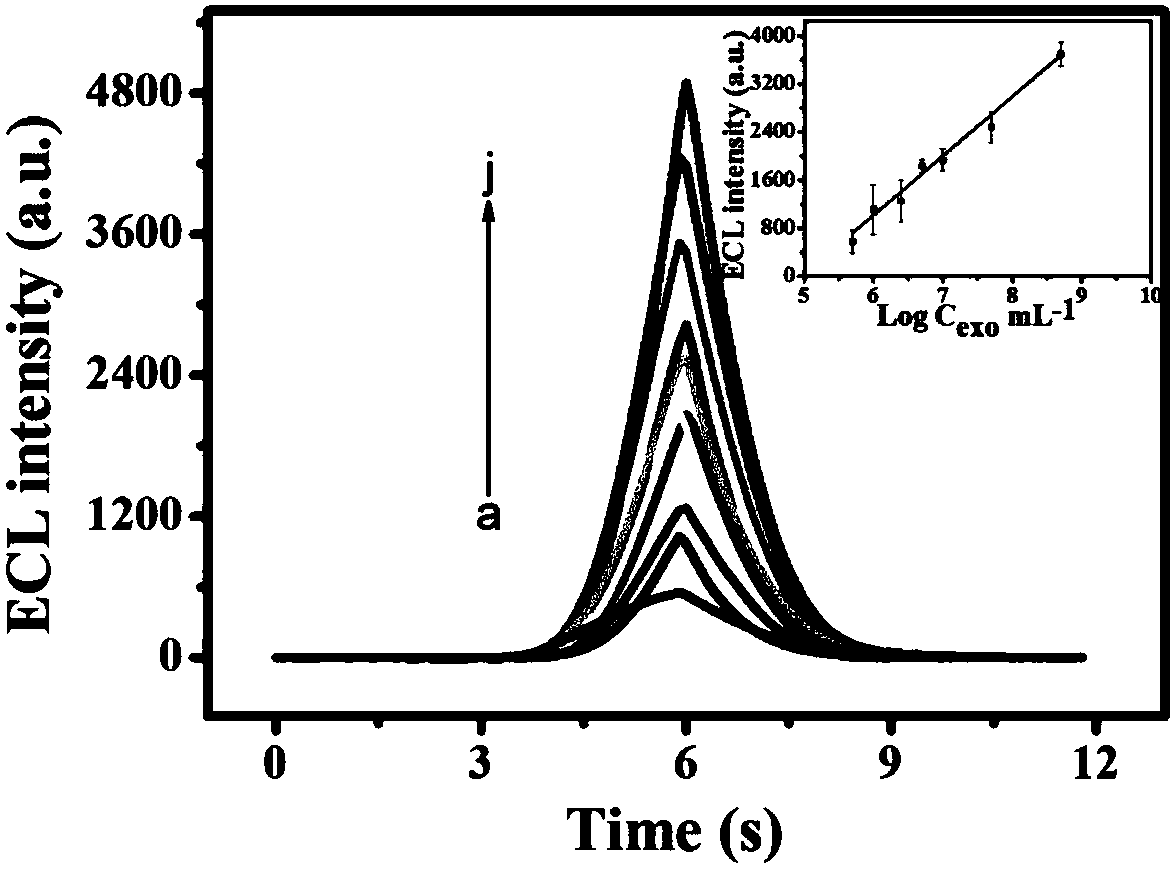Biosensor based on Ti3C2 two-dimensional metal carbide catalyzed luminol electrochemiluminescence probe and preparation method thereof
A technology of biosensors and metal carbides, applied in chemiluminescence/bioluminescence, chemical instruments and methods, organic compounds/hydrides/coordination complex catalysts, etc., can solve the problems of few application reports
- Summary
- Abstract
- Description
- Claims
- Application Information
AI Technical Summary
Problems solved by technology
Method used
Image
Examples
preparation example Construction
[0031] The present application provides a preparation method of the above-mentioned probe, linking molecules with nanosheet Ti 3 C 2 After the MXenes are placed in water and mixed evenly, they are stirred for a period of time and centrifuged to obtain a precipitate, which can be obtained by performing amide reaction with the biorecognition molecule 1.
[0032] Preferably, the stirring time is 1-1.5 h. The rotational speed of centrifugation exceeds 10000rpm.
[0033] Preferably, the reaction system of the amide reaction is 1-(3-(dimethylamino)propyl)-3-ethylcarbodiimide hydrochloride (EDC) and N-hydroxysuccinimide sodium salt (NHS).
[0034] This application preferably has a kind of etching Ti 3 AlC 2 method, the Ti 3 AlC 2 Immerse the powder in 48±2% (mass) HF and stir at 45±2°C for 24±0.5 hours, centrifuge the powder particles and wash 5-6 times at 4500-5500rpm for 5 minutes each time, discard the supernatant liquid, dried at room temperature to obtain multilayer Ti ...
Embodiment 1
[0052] Synthesis of MXenes-aptamer1 nanoprobes
[0053] Ti 3 AlC 2 (1.0 g) powder was immersed in 15 mL of 48% (mass) HF and stirred at 45°C for 24 hours. Centrifuge and wash the powder particles at 5000rpm several times for 5 minutes each time, discard the supernatant, and dry at room temperature to obtain the layered Ti 3 C 2 T x , and store at 4°C for later use.
[0054] Layered Ti 3 C 2(0.05g) powder was immersed in 1mL DMSO and stirred at room temperature for 24 hours, centrifuged at 12000rpm for 5 times, 5 minutes each time, then discarded the supernatant and added deionized water to pulverize in a cell lyser for 2 hours, and finally , the solution was centrifuged at 3500rpm for 60 minutes, and the supernatant (that is, the nanosheet Ti 3 C 2 MXenes dispersion) and stored at 4°C for future use. For its structural characterization, see figure 2 .
[0055] Mix 200 μL (0.005 g / mL) of PEI and 3 mL of nanosheet Ti 3 C 2 MXenes were mixed, then 2 mL of deionized...
Embodiment 2
[0067] This embodiment is the same as Embodiment 1, the difference is:
[0068] Assembly of electrodes
[0069] GCE after AuNPs modification treatment: Take 6 μL of AuNPs (18nm) dispersion and drop it on the surface of the glassy carbon electrode, incubate at 37°C until dry, then soak the electrode in 400 μM EDC, 100 μM NHS, and 2 mg / mL EDA at 37°C Under incubation for 2h. At the same time during this period, 1mg mL -1 Mix 40 μL each of carboxy-terminated PNIPAM, 400 μM EDC, and 100 μM NHS, and activate at room temperature for 1 h. The glassy carbon electrode incubated in EDA was further soaked in the activated PNIPAM solution for 1 hour, and incubated for 1 hour. Then the electrode was immersed in 0.8 μM aptamer2, incubated at 37°C for 2 hours, washed and dried to obtain a biosensor electrode, which was designated as aptamer2 / PNIPAM / AuNPs / GCE.
[0070] Assembly of the sensor
[0071] Submerge aptamer2 / PNIPAM / AuNPs / GCE in different concentrations of exosomes for 1 h at 25...
PUM
 Login to View More
Login to View More Abstract
Description
Claims
Application Information
 Login to View More
Login to View More - R&D
- Intellectual Property
- Life Sciences
- Materials
- Tech Scout
- Unparalleled Data Quality
- Higher Quality Content
- 60% Fewer Hallucinations
Browse by: Latest US Patents, China's latest patents, Technical Efficacy Thesaurus, Application Domain, Technology Topic, Popular Technical Reports.
© 2025 PatSnap. All rights reserved.Legal|Privacy policy|Modern Slavery Act Transparency Statement|Sitemap|About US| Contact US: help@patsnap.com



